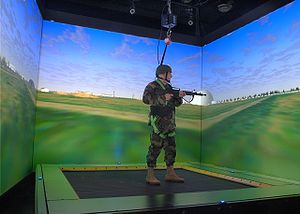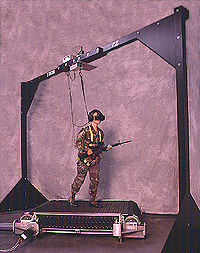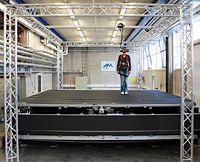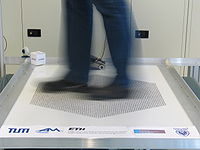
Omnidirectional treadmill
Encyclopedia

Treadmill
A treadmill is an exercise machine for running or walking while staying in one place. The word treadmill traditionally refers to a type of mill which was operated by a person or animal treading steps of a wheel to grind grain...
s differ from their basic counterparts (that permit only unidirectional locomotion
Animal locomotion
Animal locomotion, which is the act of self-propulsion by an animal, has many manifestations, including running, swimming, jumping and flying. Animals move for a variety of reasons, such as to find food, a mate, or a suitable microhabitat, and to escape predators...
). Omnidirectional treadmills are employed in immersive virtual environment implementations to allow unencumbered movement within the virtual space through user self-motion.
Advantages to pairing an ODT with an immersive virtual environment include:
- Natural navigational movement of the system user within the enclosure while still providing context cues which simulate physical traversal through the virtualVirtualThe term virtual is a concept applied in many fields with somewhat differing connotations, and also, differing denotations.The term has been defined in philosophy as "that which is not real" but may display the salient qualities of the real....
terrain
- Reverting immersive navigation tasks from hand-based (mouse, joystick) to mentally hard-wired whole body (leg) based
- Enhancing immersion by providing a whole-body experience that begins at the soles of the feet and ends at the top of the head
- Facilitating whole-body haptic interaction
History

United States
The United States of America is a federal constitutional republic comprising fifty states and a federal district...
to David E. E. Carmein on October 8, 1996.
This unit employed a belt made from plastic, toothed rollers. It employed mechanical tracking using a body harness, and included provisions for pneumatically powered, full-body force feedback for haptic and force display. The photo at right shows this unit with its first mechanical tracking arm.
At the University of Tsukuba VR Lab, Dr. Hiroo Iwata's group independently conceived and built a belt-based ODT in 1999. It had individual treadmill segments each powered by its own servomotor. It is known as the Torus Treadmill because, as with all treadmills of this class, the active surface forms a flattened torus.
In 2003 the Department of Computer Science and Information Engineering at Tamkang University in Taiwan built a passive treadmill surface consisting of balls constrained within a concave walking surface. It relies on the users energy to move the balls during walking, and a waist harness to provide counterforce. This design is quite similar to the virtual space navigation device described in Michael Crichton
Michael Crichton
John Michael Crichton , best known as Michael Crichton, was an American best-selling author, producer, director, and screenwriter, best known for his work in the science fiction, medical fiction, and thriller genres. His books have sold over 200 million copies worldwide, and many have been adapted...
's book Disclosure
Disclosure (novel)
Disclosure is a novel by Michael Crichton, published in 1994. The novel is set in a fictional high tech company, just before the beginning of the dot-com economic boom...
.
The CyberWalk Project began in 2005 through a European Commission funded collaboration of several universities. Their first design, like Tamkang University, relied on a bed of rotating balls. Unlike TU's design, CyberWalk's Cybercarpet actively powers the balls by rotating a standard linear treadmill underneath. A prototype has been produced which was big enough to evaluate the behaviour under conditions of normal walking.

In 2007 another omnidirectional platform was released by the Cyberwalk project: The Cyberwalk itself. It also uses belts which form a torus and claims to be sizeable by its architecture without limitations. The whole system will be implemented in the Cyberneum in Tübingen, Germany.
Future directions and discussion
Natural navigation employing the ODT has two fundamental, parallel paths. One path seeks to create wholly immersive, obstruction free environment as in virtual realityVirtual reality
Virtual reality , also known as virtuality, is a term that applies to computer-simulated environments that can simulate physical presence in places in the real world, as well as in imaginary worlds...
, the other seeks a lower cost, more restricted device. The immersive vision is that of a large active surface upon which the immersant is able to walk freely and unfettered. The second approach employs a harness for tracking, and optionally provides whole-body force feedback.
Both approaches have their advantages and disadvantages. Without a harness, the ODT user is able to accelerate away from center of the surface. The system must recognize this using a variety of sensing means, and gently accelerate the user back towards the center. Keeping the forces that return the user to center below the human sensing threshold is the main challenge with these systems. The larger the active surface, the easier it is to control using this means.
With a harness, the user is kept on center mechanically, and the surface area can be made much smaller. But actions such as rolling are not possible. On the plus side, a harness can provide body forces such as inertia or slope display. In addition, the harness may provide lifting force to simulate free-body flight. And the well-defined user space makes interaction with outside haptic devices feasible.
Related efforts
Several alternative whole-body human-computer interfaces exist. The VirtuSphereVirtuSphere
VirtuSphere is a virtual reality device. It is, as the name suggests, spherical. It consists of a 10-foot hollow sphere, which is placed on a special platform that allows the sphere to rotate freely in any direction according to the user’s steps...
permits a person to walk on the inside surface of a large, hollow ball. Like the Tamkang University's device, the VirtuSphere is passive. It requires user energy input to start and stop sphere rotation.
Walking- or stepping-in-place as a substitute for real walking was researched by Slater, Steed, and Usoh, at the University of London, in 1993. More recently, the US Navy's VIRTE
VIRTE
VIRtual Training and Environments was an Office of Naval Research Science and Technology program from 2002 to 2007 led by CDR Dylan Schmorrow. It was funded under the Capable Manpower Future Naval Capability and produced ground breaking research in Virtual Environments. The VIRTE program was...
project employed walk-in-place as a substitute for real walking. A similar approach by the Southwest Research Institute uses a walking pad.
Besides an ODT, the University of Tsukuba VR Lab has built numerous prototypes of various natural navigation walking devices. These have included rollers on shoes combined with a waist harness and the CirculaFloor, a group of smart tiles that arrange themselves to recycle from the rear of an active surface to the front. A computer-animation of this concept and a demonstration of a prototype are available on YouTube.
D. Johansson and L.J. de Vin at the University of Örebro in Sweden, presented a new approach, which reduces the mechanical and control complexity of the two-dimensional walking problem virtually down to one dimension. The floor uses a 16-sided polygon of triangular treadmills in order to always transport the user back towards the centre whilst at the same time allowing walking in all directions. The floor is commercially available and manufactured by MSE Weibull in Sweden.
Numerous references to walking interfaces for virtual reality environments exist in the US Patent Office database. Most of these have not been reduced to practice. There are parallel developments being conducted by researchers working on projects sponsored by the Department of Veterans Affairs to create virtual reality environments for a wheelchair trainer
Wheelchair Trainer
A wheelchair trainer or wheelchair treadmill is an apparatus that allows a manual wheelchair user to simulate linear travel while remaining stationary in a manner similar to an ambulatory person walking or running on a treadmill or a cyclist pedaling a bicycle on a bicycle trainer...
in order to promote therapeutic exercise. The bicycle trainer
Bicycle trainer
A trainer, or turbo trainer, is a piece of equipment that makes it possible to ride a bicycle while it remains stationary. They are commonly used to train for races, or when riding conditions outside are not favorable...
can also interface with computer generated environments to provide virtual navigation capabilities.
Potential uses

- Entertainment
- Exercise
- Training
- Imprisonment
- Education
- Physical rehabilitation
- Post Traumatic Stress Disorder treatment
- Motion capture
- Real-time virtual actor input
- Fully immersive gaming and virtual realityVirtual realityVirtual reality , also known as virtuality, is a term that applies to computer-simulated environments that can simulate physical presence in places in the real world, as well as in imaginary worlds...
simulations

